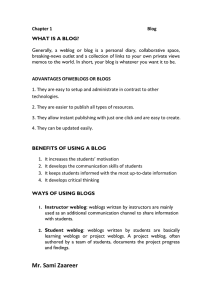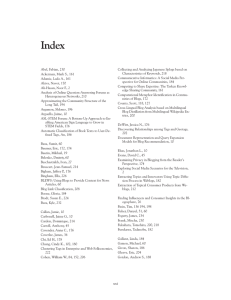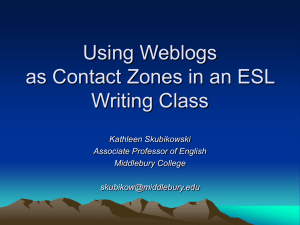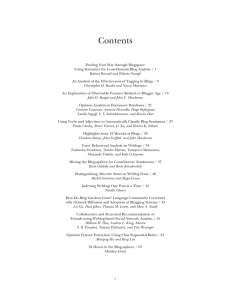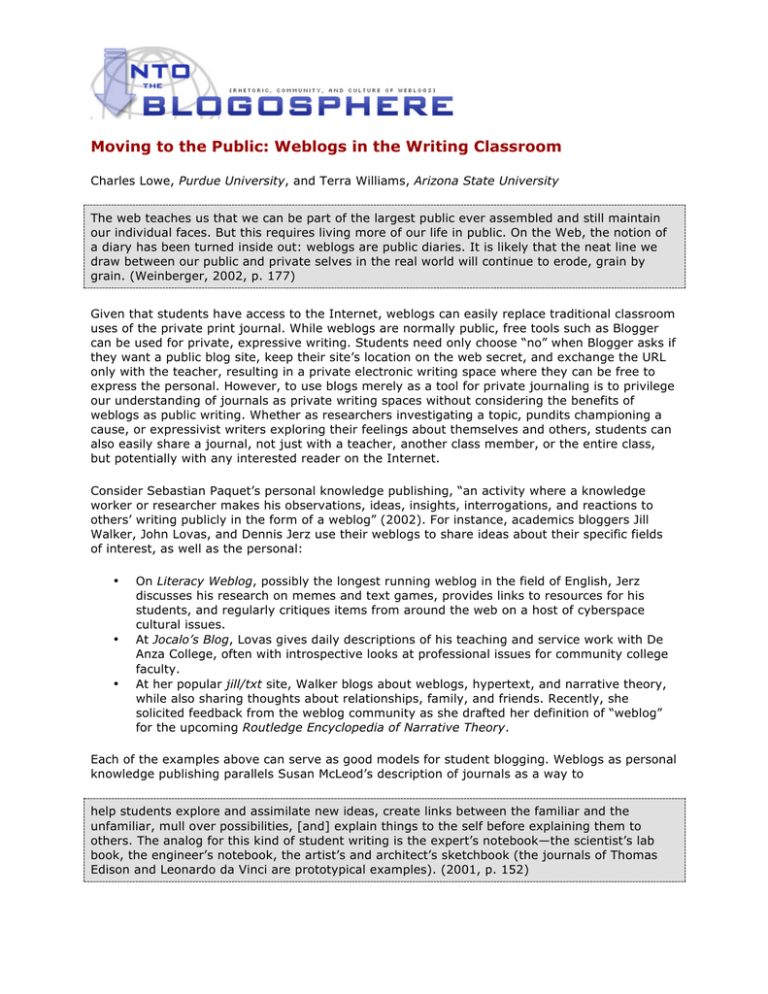
Moving to the Public: Weblogs in the Writing Classroom
Charles Lowe, Purdue University, and Terra Williams, Arizona State University
The web teaches us that we can be part of the largest public ever assembled and still maintain
our individual faces. But this requires living more of our life in public. On the Web, the notion of
a diary has been turned inside out: weblogs are public diaries. It is likely that the neat line we
draw between our public and private selves in the real world will continue to erode, grain by
grain. (Weinberger, 2002, p. 177)
Given that students have access to the Internet, weblogs can easily replace traditional classroom
uses of the private print journal. While weblogs are normally public, free tools such as Blogger
can be used for private, expressive writing. Students need only choose “no” when Blogger asks if
they want a public blog site, keep their site’s location on the web secret, and exchange the URL
only with the teacher, resulting in a private electronic writing space where they can be free to
express the personal. However, to use blogs merely as a tool for private journaling is to privilege
our understanding of journals as private writing spaces without considering the benefits of
weblogs as public writing. Whether as researchers investigating a topic, pundits championing a
cause, or expressivist writers exploring their feelings about themselves and others, students can
also easily share a journal, not just with a teacher, another class member, or the entire class,
but potentially with any interested reader on the Internet.
Consider Sebastian Paquet’s personal knowledge publishing, “an activity where a knowledge
worker or researcher makes his observations, ideas, insights, interrogations, and reactions to
others’ writing publicly in the form of a weblog” (2002). For instance, academics bloggers Jill
Walker, John Lovas, and Dennis Jerz use their weblogs to share ideas about their specific fields
of interest, as well as the personal:
•
•
•
On Literacy Weblog, possibly the longest running weblog in the field of English, Jerz
discusses his research on memes and text games, provides links to resources for his
students, and regularly critiques items from around the web on a host of cyberspace
cultural issues.
At Jocalo’s Blog, Lovas gives daily descriptions of his teaching and service work with De
Anza College, often with introspective looks at professional issues for community college
faculty.
At her popular jill/txt site, Walker blogs about weblogs, hypertext, and narrative theory,
while also sharing thoughts about relationships, family, and friends. Recently, she
solicited feedback from the weblog community as she drafted her definition of “weblog”
for the upcoming Routledge Encyclopedia of Narrative Theory.
Each of the examples above can serve as good models for student blogging. Weblogs as personal
knowledge publishing parallels Susan McLeod’s description of journals as a way to
help students explore and assimilate new ideas, create links between the familiar and the
unfamiliar, mull over possibilities, [and] explain things to the self before explaining them to
others. The analog for this kind of student writing is the expert’s notebook—the scientist’s lab
book, the engineer’s notebook, the artist’s and architect’s sketchbook (the journals of Thomas
Edison and Leonardo da Vinci are prototypical examples). (2001, p. 152)
In our classes, students use their blogs for a wide range of writing, much like a combination of a
commonplace book and a diary put together. Blog entries include:
•
•
•
•
•
Reading responses;
Articles and items of interest that they find on the web that are related to class—texts
about writing, for example;
Research responses (akin to the double-entry journal as defined by Bruce Ballenger
in The Curious Researcher);
Personal explorations on topics ranging from “Ten Things I Really Like About Myself” to
favorite family traditions and pet peeves; and
Off-topic blogs/journals. Our students, of course, have an open invitation to submit offtopic blogs/journals. Off-topic posts have included a lament about a flea-infested
apartment, a link to an article about the Sims Online, a link to downloadable Esheep—and
“They’re so cute!” comments—and various day-in-the-life-of-a-college-freshman blogs.
McLeod’s definition, though, along with other discourse on journals in composition, restricts
journal writing to the completely private or the immediacy of the classroom. Weblogging, as a
publishing phenomenon which allows anyone—even those with little technical expertise—to
maintain a website and regularly write online, promises to complicate journaling with the
introduction of the public. As two teachers who have used weblogs in our classrooms for the past
two years, we have found that by extending the discourse to a large community outside of the
classroom, our student bloggers regularly confront “real” rhetorical situations in a very social,
supportive setting.
Using Weblogs to Connect to the Valuable Public
Sharing journals within the writing classroom is not a new concept. Well before weblogs became
popular, Chris Anson and Richard Beach (1995) encouraged teachers to extend the principles
behind the dialogue journal to peer dialogue journals, where, working in pairs or groups of three,
students share journals entries. Like weblogs can, peer dialogue journals provide students “with
the social interaction and motivation to extend their writing” not available through private journal
writing (p. 65). However, as Anson and Beach caution, the logistics of sharing print texts could
make it difficult to coordinate and exchange dialogue journals in the classroom. As an
alternative, they suggest emailed peer dialogue journals, “interactive environments” that can
create “a strong sense of community in which students can assume an active role as a
participant” (p. 76). Though they make sharing more logistically sound, emailed peer dialogue
journals still keep sharing within the walls of the classroom.
Because of the benefits of social interaction, most writing teachers would agree that students
sharing their writing—making their writing public—is important. For example, in their
introduction to Public Works: Student Writing as Public Text, Emily Isaacs and Phoebe Jackson
note Kenneth Bruffee’s contribution to our understanding of the importance of public writing:
Bruffee
emphasizes the value of the social nature of public writing, a condition he identifies as common
in nonacademic settings. In his work, Bruffee argues strenuously for students to go public with
their writing to receive feedback, on the grounds that public writing in classrooms deemphasizes
teacher authority and promotes student-writers’ abilities to see themselves as responsible
writers and to view writing as a social activity. (2001, p. xii)
Such principles inform our understanding of peer response and are now integrated into process
theory. Writing teachers commonly use small group or full class workshops as the means for
students to share their writing. By making their writing public in class, students begin to take
2 responsibility for/ownership of what they have to say rather than handing it directly over to a
teacher-reader-grader. Writing teachers have also extended this notion to electronic discourse.
Many use email as a way for students to share drafts or configure electronic writing spaces in
course management systems. Teachers even create journal spaces in Blackboard or WebCT
discussion boards.
These electronic spaces are not quite private; however, they are not quite public, either. For
instance, Blackboard and WebCT, with their emphasis on content delivery and teacher
administration functions, are classroom-only gated communities. Institution-maintained course
management sites may have WWW addresses and contain links to other Internet sites, but as
they move through the password-protected virtual hallways, students easily realize such online
class spaces are not the information superhighway. Instead, they are only one way streets that
pull content without contributing to the larger discourse which is the web. Within passwordprotected classroom spaces, these student writers are safely sequestered from the discourse
community of the Internet.
Many common writing class practices, like the use of Blackboard and WebCT, reflect a restricted
definition of public, a rhetorical situation with which students are all too familiar after years of
writing for English classes: that of the classroom, a place in which the grade and the teacher are
largely what matter. Recognizing this, teachers often try to expand the audience that students
write for by asking them to articulate imagined or simulated rhetorical situations for writing
projects, such as “write in the manner of the ‘Talk of the Town’ essays found at the beginning of
each week’s New Yorker magazine” (Bishop, 2004, p. 183). Or, teachers may ask students to
choose a publication and write an article in which the subject matter, voice, and style are
congruent with what might be found in that publication. The problem with such artificial
rhetorical situations is that ultimately, the real audience is still the teacher—and students know
this. As a consequence, some teachers have students work with real audiences outside of the
class. Students write for class newspapers or zines and do service learning activities where the
final product is shared with an organization or community
We believe, as Catherine Smith does, that students “take real-world writing more seriously when
it is done on the web, where it might actually be seen and used” (2000, p. 241). Many students
today regularly email friends and family, converse via instant message daily, participate in
multiplayer online games with people from around the web, and surf Internet sites much as
earlier generations read magazines and newspapers. Students see the web as a public, playful
place different from the writing spaces they typically work in within the classroom. Recognizing
this, some composition teachers now assign individual hypertexts or group hypertext projects
such as webzines, hoping to tap into the students’ sense of play and familiarity with online
environments in order to stimulate investment in and engagement with their writing.
Student hypertext projects expand the concept of the public audience to include the entire web.
Yet, weblogs as a social, public genre can have equal if not more appeal to a generation who
enjoys seeing the private made public on Survivor and MTV’s Real World, while also fulfilling the
pedagogical goal of expanding audience outside of the classroom. When students hesitate to
share their texts publicly—given the association of the word “journal” with the word “private”—an
exploration of weblogging will clarify for them that a weblog is a public way of sharing ideas.
Each semester, we introduce our students to weblogs by asking them to visit weblogs.com and
by engaging them in discussion of articles such as Rebecca Mead’s “You’ve Got Blog: How to put
your business, your boyfriend, and your life on-line” (2000). Through these activities and after a
little time gaining experience as bloggers, students come to see weblogs as a fun communication
medium in which they can and want to participate as writers and readers.
Weblogs, as an electronic publishing tool, also offer significant practical and pedadogical
differences and advantages over student hypertext assignments for both writing teachers and
students alike. In light of the following comparisons, writing teachers may appreciate Pat
3 Delaney’s (2002) “analogy of the Dreamweaver and ftp-ed webpage as ‘paper making’ and
blogging as ‘writing on pre-made digital paper’”:
•
•
•
•
Webpage projects generally require specialized software, such as Netscape Composer or
Dreamweaver, and a file transfer method, applications which may only be available in
classrooms or school computer labs or need to be purchased or downloaded onto
students’ personal computers. Since weblogs are a browser-based application, students
can work from almost any computer that has Internet access.
Students then have to learn to use the specialized applications for creating webpages,
understand server file management, and learn some HTML basics, requiring the teacher
to act as a web design tools educator and technical support. Teaching students to use
weblogs is very simple: most weblog programs use web-based forms where students can
enter plain text, much as they would when creating an email or using an online
discussion board.
Teachers not only have to serve as technical support for using specialized applications,
but also serve as techno-rhetoricians. Jonathan Benda (2001) points out that students
“lack background in the principles behind designing a Web site that really communicates
something to an audience” (63). With the emphasis on creating text and not graphical
layouts when using weblogs, teachers can focus on writing for the web without getting
into graphical design and visual rhetoric.
Web pages that students create are usually static HTML—to be read, but without any
opportunity for reader feedback on the site. Blog software is much more interactive; most
include comment boards, allowing readers to easily attach feedback to any post.
Using Delaney’s “digital paper,” we’ve found that blogging and reading blogs prepares students
to write online. Weblogs can serve as an alternative to hypertext assignments, or even make
hypertext assignments more effective. In our experience, students sometimes get carried away
with the eye-candy of website design—images, fancy layouts, Marcomedia Flash—at the expense
of working on the alphanumeric part of their texts. Working with weblogs privileges writing:
students are more invested in the writing that goes into end-of-the-semester hypertext projects
when they’ve been writing for the web all semester. They learn rhetorical strategies for writing
online before moving on to work with graphics. They also learn about how to make effective
hyperlinks—a crucial part of website design and blogging. Thus, students spend more time
developing their texts, rather than working mostly on graphics and choosing the “perfect”
background. These texts likely end up being more rhetorically sensitive than without the
intervention of the blog.
Weblogs as Social, Public Writing Spaces
As writing teachers, we typically feel it our duty to protect our students, to create safe writing
spaces where students can enjoy greater risk-taking. Traditional print journal writing, used as a
private writing space, typically embodies this notion. It is no wonder that teachers fear having
students post personal reflections, drafts, reading responses, and other writing assignments and
exercises to the public Internet, preferring instead the locked doors of a Blackboard or WebCT
site. For example, Charles Moran’s
experience with Web publishing has made [him] consider a rather frightening possibility: that
computer technologies, as we are presently using them, move all of us in our first-year writing
courses toward the production and publication of ‘documents’ that will live in the public sphere,
and away from more or less private writing that will help us compose our lives. (Moran, 2001, p.
40)
4 Moving journal writing to the web using weblogs where Internet surfers can read and link to
student writing potentially opens our students’ texts to the unknown outside of the classroom,
but our experience with student blogging has shown that “less private writing” may equally help
writers to compose their lives, albeit in a social, more public way. And even though this
speculation about the positive aspects of public writing may disrupt established thoughts on what
should be public and private, it is not out of line with collaborative process views. Lisa Ede and
Andrea Lunsford (1990) note that the solitary writer image permeates “the theory and practice
of teaching writing” (6). Composition has traditionally privileged dialectic and Platonic
perspectives on invention in writing (LeFevre, 1987, pp. 49-50). The scholarship often depicts
the writer, working alone, drawing on deeply divined personal truths or engaging in inner
dialogue as the means of creating knowledge. While composition theory and practice now
recognizes the importance of collaboration and social interaction more than it did twenty or even
ten years ago, we still suspect that our field’s expressivist heritage may lead many writing
teachers to put the private unnecessarily in front of the public, partially because writing teachers
are themselves more comfortable with the private. As a consequence, many writing assignments
include opportunities for deep, personal reflective writing that is not possible within the public
eye. But what is the tradeoff for that kind of writing opportunity for students? Isn’t it possible
that the paradoxical situation of creating a risk-free space in which to enable risk-taking has led
compositionists to forget a primary purpose of privacy, which is to provide a comfortable writing
space, comfort which can also come from community?
Regardless, despite the fact that publicly posting to the web may limit some instances of deeply
personal expression, we want to encourage writing teachers to be aware of their possible biases
for private writing spaces when thinking about weblogs. In her 1987 report on a computermediated graduate course, Linda Harasim highlights some of the new options in education that
computers have opened, suggesting that computers can, in some cases, be more effective than
the traditional classroom (1997, p. 118). Below, we show that using weblogs in our classrooms
has been more effective for at least some of our students because it has increased
participation: our quieter students who typically don’t participate in face-to-face discussions are
participating in weblog discussions. Making a similiar claim, S.R. Hiltz’s early research in online
learning concludes, “[W]e believe that one important requirement for realizing the promise of
new educational technologies is to use them to create new learning and teaching environments
that are more effective and exciting for at least some kinds of materials rather than merely
trying to replicate the traditional classroom electronically” (1986, 104).
Differing in important ways from other genres traditionally used in the writing classroom and on
the Internet, weblogs are, as Mark Federman explains,
an instance of “publicy” - the McLuhan reversal of “privacy” - that occurs under the intense
acceleration of instantaneous communications. Our notion of privacy was created as an artifact
of literacy - silent reading lead to private interpretation of ideas that lead to private thoughts
that lead to privacy. Blogging is an “outering” of the private mind in a public way (that in turn
leads to the multi-way participation that is again characteristic of multi-way instantaneous
communications). Unlike normal conversation that is essentially private but interactive, and
unlike broadcast that is inherently not interactive but public, blogging is interactive, public and,
of course, networked - that is to say, interconnected. (2004)
Compare this to Jill Walker’s observation on jill/txt, that “the traditional solitude of writers is so
different from the companionship of blogs.” Or pioneer edublogger Will Richardson’s conclusions
about his K-12 literature class where blogging “stimulate[d] debate and motivate[d] students to
do close reading of the text” (2003, p. 40). Each of these is an instance of “publicy” that fits very
nicely with Bruffee’s social constructionist views of writing. For instance, Bruffee (1984) explains
that “if thought is internalized public and social talk, then writing of all kinds is internalized social
talk made public and social again. If thought is internalized conversation, then writing is
5 internalized conversation re-externalized” (1984, p. 641). Blogging, then, with its networked,
informal conversational style, is less thought, and more externalized public and social talk.
From a Bruffean perspective, then, weblogs can facilitate a collaborative, social process of
meaning making, leading us to believe that weblogs as an instance of “publicy” enable a comfort
zone, a social environment where anxiety about the teacher and of school writing is reduced,
while also drawing on other benefits of writing publicly.
•
•
•
•
•
When our students write about a bad day or a difficult personal experience of some kind,
quite often someone else in the community will post a comment of consolation. One of
Terra’s students from the fall of 2003 posted a message about how having strep throat
forced him to quit smoking—cold turkey. Several students posted encouraging words,
including one who wrote, “I have only had ONE cigarette in the past 2 days, so I guess
you can say that you are kind of an inspiration. Once reading your blog, I realized that I
would never want to feel the way you did, and I am now going to try and quit.” Another
student in Charlie’s class injured her ankle and was somewhat immobilized for a few
weeks, unable to attend class and largely confined to her room. When students in the
class saw her declarations of loneliness in her blogs, they more frequently responded to
her posts, making a special effort to continue to include her in the blogging community
that existed outside of face-to-face class meetings.
In reference to peer dialogue journals, Anson and Beach explain through the sharing of
their journal writing, that students “create their own social support network” (1995, p.
66). Comfort, then, as with the examples above, may be said to come from what Karen
LeFevre has defined as resonance where “an individual act—a ‘vibration’—is intensified by
sympathetic vibrations” (1987, p. 65). One student noted in a mid-term evaluation, “I
like the way that we have our own little corner of the world that we can do what ever
(PG-13 guys) we want in it. If something were bothering us we could state it and then
have our fellow classmates comment with solutions, help, or maybe just a kind word that
will cheer us up.” Blogging thus creates a sympathetic space through social interaction,
friendliness, and positive, useful feedback—a place where writers don’t have to become
comfortable with their writing before sharing.
Frequent blogging reduces anxiety about publishing to the web, about writing publicly.
We’ve found that students’ apprehension about blogging usually disappears within a few
weeks as they become “comfortable”; for example, students often expressed views such
as: “I think that as I got more comfortable with [the course weblog] my participation has
increased.”
In our classes, blogging is a constant from the beginning of class to the end. There
should be some long-term effects of public writing even after the first few weeks that
aren’t seen in classes where public writing is a once-a-semester or occasional project. For
example, students have told us at the mid-term that they were very skeptical of blogging
in the beginning of the class, but the initial discomfort they felt about sharing their work
disappeared once they discovered it was actually fun to read everyone else’s writing and
be able to post comments when they were compelled to do so. Three weeks into the fall
2003 semester, when asked to evaluate their experiences with blogging, a student wrote,
“I like blogging because I believe it to be a positive experience for shy people. At times I
don’t speak up in class because I get frightened. It’s much easier for me to express my
opinion on paper and it’s easier for me to take criticism on paper. I think blogging will
bring up new ideas that might not have been spoken in an in class environment. Many
people aren’t as intimidated to speak their mind online.”
Some students said they would read through what others had written in order to get
ideas about what was acceptable and what had already been covered so that they
wouldn’t repeat the same ideas in their writing. Here we see that the writing students are
doing has a direct impact on what others write: “I [read the messages already posted on
a given topic or assignment] so I can get a feel on how others interpreted the
assignment.”
6 •
Blogging represents the interaction of a community in the sense that all posts are subject
to concerns about audience. In a classroom that uses weblogs extensively for posting
content, as well as discussion and feedback from peers, the ongoing conversation
becomes the voice of that community, which can make itself heard over the voice of any
one, including the teacher. With the teacher no longer the overly predominant active
reader and responder of student texts, students, as a community, take more ownership
of their writing. Writing teachers should remember that much of the purpose of private
writing is to create a teacherless writing space where students take ownership. Peter
Elbow (1998), himself, arrived at freewriting as a means of escape from the anxieties
created by a history of writing instruction. Private writing created a comfortable place
where he could find himself as a writer; public writing through weblogging can do the
same. One student writes:
When I first looked over the syllabus for the class before the first day of school and I saw
the word ‘blog’ all over the place, I was like what??? I had never ever heard of the word
blog… So I got a little nervous, but I realized that I probably wasn’t the only one who
didn’t know what a blog was, so I decided not to freak out and keep a positive outlook on
the class. Now, 3 weeks into the class, I love blogging! It’s really cool! I really like how
you can read what other people wrote, and other people can comment on what you wrote
so you get some feedback from your class mates. It’s also a really good way of
communication and you get to know people in a sort of different way, other than meeting
them face to face.
Another student wrote:
What I have enjoyed most about blogging is that even though we have certain topics to
expand upon, I can post my own thoughts and feelings in a relaxed environment. As I
have already stated in a previous blog, being in relaxed environment when you write is
probably one of the best things for your writing. You can always write how you feel about
the desired topic that you have to blog about.
•
•
Like print journals, blogging encourages the sort of informal writing where students can
share invention work, drafts, half-formed ideas—always with sharing as the common
focus. But because sharing is the common focus, students still have a rhetorical situation
to consider since they are writing for a real audience; as a consequence, they seem to
take more pride in all of their work, even exploratory writing. One student notes,
“Blogging is a interesting thing that has been really fun for me to learn how to do and I
know that with each new blog I will get better and better at expressing my message in a
neat, clear and concise way so that all who read it will get a feel of me and my ideas.”
And as Theodore Humphrey (1999) suggests about online writing in general, students
may also work harder: “Their work is constantly being shared with and receiving
responses from their peers as well as their professor. The rhetorical concept of audience
emerges almost without awareness into the consciousness and practice of the students.”
On working harder, one student confessed, “I could show improvement in the ‘insightful’
department. I’ve noticed that my blogs aren’t as insightful and original as the other
blogs.”
Some would point to other student web texts—zines and student websites—and suggest
that they, too, can accomplish the same goals without the need to share drafts and other
exploratory writing, that students can wait until a finished product is ready to share
publicly. Yet, we feel that such texts diminish the process of drafting and do not create
discourse about the drafting process in the same way that making the entire process
public does. In only publishing the final draft—such as in the case of many zine projects
7 and student websites that we have seen—isn’t this practice overly valuing the final
product and, in doing so, also undercutting writing process pedagogy?
Writing for the Future
In “Digital spins: The pedagogy and politics of student-centered e-zines,” Jason Alexander’s
(2002) introduction talks about how “staged” audience is in first year composition. Alexander
points out that even just sharing papers among students on the Internet is not enough, and goes
on to problematize posting to the web, suggesting that students realize that their
only real audience is fellow students and the teacher. However, we would say that by using
weblogs in our classrooms, we’ve turned ownership over to students and given them a real
audience. In life outside of the classroom, much like on the Internet, writers will not always know
who their audiences are when they write. A report, memo, letter, or fax might cross the desks of
numerous people that the writer has never met during the course of a workday. Risk is part of
writing, and our students experience that risk within a very supportive community of writers.
When we first began teaching with blogs, Charlie recalls being apprehensive himself about
putting course syllabi, feedback on drafts, and other teacherly responses up on the web for
everyone to see, even though he had been posting to an academic blog for almost six months.
But we both feel now, that the shared meaning we and our students have gained from blogging
our courses makes it all worthwhile. Imagine. Classes within and among institutions could
interact through the use of weblogs as more institutions integrate student blogging into the
curriculum (see, for example, the University of South Florida’s First-Year-Writing
Program’s Writing Blogs site).
We hope that researchers and practitioners will take our exploratory, experienced-based musings
and extend the dialogue on weblogs in the classroom, opening themselves to the many
possibilities of publishing to the web now that blogging makes practically anyone a web author.
Maybe others will come to feel, as we do, that there is something exciting about the way that
weblogs facilitate sharing and build community by putting more of our lives online.
References
Alexander, Jonathan. (2002). Digital spins: The pedagogy and politics of student-centered ezines. Computers and Composition, 19, 387-410.
Anson, Chris & Beach, Richard. (1995). Journals in the classroom: writing to learn. Norwood:
Christopher-Gordon Publishers.
Ballenger, Bruce. (2004). The curious researcher: A guide to writing research papers. (4th ed.).
New York: Pearson Longman.
Benda, Jonathan. (2001). Field trips to virtual public squares? Purposes, audiences, teachers,
and student-written web pages. In Emily Isaacs and Phoebe Jackson (Eds.), Public
Works: Student Writing as Public Text (pp. 61-68). Portsmouth: Boynton/Cook.
Bishop, Wendy. (Ed.). (2004). On writing: A process reader. New York: McGraw-Hill.
Bruffee, Kenneth. (1984). Collaborative learning and the conversation of mankind. College
English, 46(7), 635-52.
8 Delaney, Pat. (2002, July 12). Forests and forests of digital paper. homoLudens. Author.
Retrieved March 3, 2004, from http://interactiveu.berkeley.edu:8000/PatD/2002/07/11.
Ede, Lisa & Lunsford, Andrea. (1990). Singular texts/plural authors: Perspectives
on collaborative writing.Carbondale: Southern Illinois UP.
Elbow, Peter. (1998). Writing Without Teachers. (Anniv. ed.). New York: Oxford Press.
Federman, Mark. (2004, December 26). Blogging and publicy. What is the message? Author.
Retrieved January 21, 2004,
from http://www.mcluhan.utoronto.ca/blogger/2003_12_01_blogarchive.html#10718409
3362428431.
Harasim, Linda. (1997). Teaching and learning online: Issues in computer-mediated graduate
courses. Canadian Journal of Educational Communication,16(2), 117-135.
Hiltz, S.R. (1986). The “virtual classroom”: Using computer-mediated communication for
university teaching.Journal of Communication, 36(2), 95-104.
Humphery, Theodore. (1999). Literature on-line: the best of all possible worlds? Currents in
electronic literacy, 1. Retrieved January 21, 2004,
from http://www.cwrl.utexas.edu/currents/spr99/humphrey.html.
Isaacs, Emily J. and Phoebe Jackson. (Eds.). (2001). Public works: Student writing as public text.
Portsmouth: Boynton/Cook.
Jerz, Dennis. Literacy weblog. Retrieved March 3, 2004,
from http://jerz.setonhill.edu/weblog/index.jsp.
LeFevre, Karen (1987). Invention as a social act. Carbondale: Southern Illinois UP.
Lovas, John. A writing teacher’s blog (Jocalo’s Blog). Retrieved March 3, 2004,
fromhttp://faculty.deanza.fhda.edu/jocalo/.
McLeod, Susan. (2001). The pedagogy of writing across the curriculum. In Gary Tate, Amy
Rupiper, & Kurt Schick (Eds.), A guide to composition pedagogies (pp 149-164). New
York: Oxford University Press.
Mead, Rebecca. (2000, November 13). You’ve got blog: How to put your business, your
boyfriend, and your life on-line. rebeccamead.com. Author. Retrieved January 21, 2004,
fromhttp://www.rebeccamead.com/2000_11_13_art_blog.htm.
Moran, Charles. (2001). Public and private writing in the information Aage. In Emily J. Isaacs and
Phoebe Jackson (Eds.), Public works: Student writing as public text (pp. 35-43).
Portsmouth: Boynton/Cook.
Paquet, Sebastian. (2002, October 1). Personal knowledge publishing and its uses in
research. Seb’s OpenResearch. Author. Retrieved January 21, 2004,
fromhttp://radio.weblogs.com/0110772/stories/2002/10/03/personalKnowledgePublishin
gAndItsUsesInResearch.html.
9 Richardson, Will. (2003). Weblogs in the english classroom: More than just
chat. English Journal, 93(1), 39-43.
Smith, Catherine. (2000). Nobody, which means anybody: Audience on the world wide web. In
Sibylle Gruber (Ed.), Weaving a virtual web: Practical approaches to new information
technologies (pp. 239-249). Urbana: NCTE.
Walker, Jill. jill/txt. Retrieved March 3, 2004, from http://huminf.uib.no/~jill.
---. (2003, November 6). solitude. jill/txt. Author. Retrieved March 16, 2004,
fromhttp://huminf.uib.no/~jill/archives/writing/solitude.html.
Weinberger, David. (2002). Small pieces loosely joined: a unified theory of the web. Cambridge,
MA: Perseus Publishing.
Writing Blogs. University of South Florida. Retrieved March 13, 2004,
from http://writingblog.org/.
Note: This article is licensed under a copyleft Attribution-Share Alike Creative Commons license.
10

